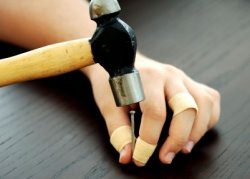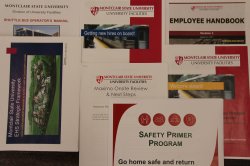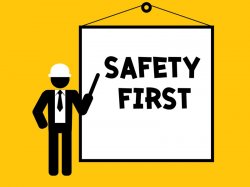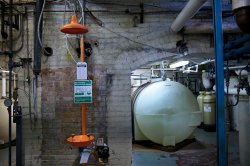Safety is a Full-Time Job. Not a Part-Time Practice
Workplace Safety
The Division of University Facilities endeavors to provide and maintain a safe work environment that will ensure compliance with federal and state guidelines, policies, and standards. Each employee is expected to promote safe work practices, to participate in occupational health and safety training and/or educational programs, and to help maintain property and equipment in a safe operating condition. If an employee has questions about the safety of his or her work environment or whether precautions are necessary, he or she should contact his or her supervisor. Employees are expected to report unsafe conditions and work practices immediately to their supervisor and follow departmental protocols.
Environmental Health and Safety (EHS) has developed a comprehensive workplace safety program involving hazard identification and assessment, education and training, and worker/employer participation.
- Hazard Identification and Assessment- EHS shall identify and evaluate hazards in order to prioritize them for control.
- Education and Training- All employees should understand University safety operations and how to execute the responsibilities assigned under safety programs.
- Worker/Employer Participation- Workers are encouraged to communicate openly with managers and supervisors and to report safety and health concerns or suggest improvements, without fear of retaliation.
What Is Machine Safety?
Montclair State University’s machine safety process is built around these seven standards:
- Compliance with the No Access policy – No employee will be able to come into contact with dangerous moving parts or condition during normal or abnormal situations.
- Lock Out/Tag Out – Prevention of exposure to inadvertent equipment or machine start-up and/or hazardous energy or materials.
- Elimination of operator bypassing of safety devices – Removal of fixed guarding or a safeguarding device is not allowed. Operators must be protected at all times.
- Fail to safe electrical wiring – High-risk (potential for death, amputation, severe fracture, etc.) machines shall have safety systems that have redundant and continuous monitoring characteristics.
- Locking interlock switches and braking devices for high inertia components – High inertia equipment continues to rotate for a period of time after power has been removed. Use of locking interlocks switches and/or braking devices are required to prevent contact until a full stop is verified.
- Safe behavior systems – Safe work methods reduce unacceptable work practices. The goal is to remove unsafe or unstructured methods from the workplace.
- Code of conduct enforcement – All employees must observe the standards that have been established in the Code of Conduct. The goal of the standard is not to blame, but to do what is necessary to eliminate unsafe acts.
Why Is Machine Safety Important?
Our ultimate goal is to provide a safe workplace for our employees. Regulatory requirements aside, employees have a responsibility to themselves and others to ensure equipment is safe to use before conducting any activity. Therefore, each employee is required to participate in injury prevention and awareness programs such as machine safety to heighten awareness of potential workplace hazards.
What Should I Do?
- Ask EHS professionals how you can help maintain a machine safety culture.
- Provide employees with documented, hands-on training of the safety features on the equipment they operate (guarding, lockout tagout, etc.).
- Involve employees in the design phase of proposed machine guarding changes to equipment in their department.
- Remind employees that bypassing or disabling a machine safety feature will result in disciplinary action or termination.
- Remind employees that machine safety features must be inspected, and any feature that is not working properly must be reported immediately.
What Is Ergonomics?
Ergonomics is fitting the job to the person rather than fitting the person to the job. We have ergonomic risks throughout our locations including machine shop, vehicle service shop, labs, and offices. Ergonomics is one of the major risks in our risk profile. Our ergonomics cases vary from a minor body pain or discomfort to surgical procedures (back, wrist, etc.).
Early reporting is critical in reducing ergonomic incidents and in decreasing the health risks employed with prolonged exposure.
Why Is Ergonomics Important?
An ergonomically correct workplace is one in which people work in a safe, healthy, comfortable and productive manner. It supports our employees’ health and our bottom line.
What Should I Do?
- Review the EJA with your EHS professionals.
- Know the ergonomic risks in your area of responsibility.
- Provide funding for ergonomic improvements and follow up their implementation.
- Support employee pauses and breaks throughout the day.
- Encourage early reporting.
- Observe employees for signs of ergonomic related stress.
Montclair State Ergonomic Program
Montclair State University’s Ergonomic Program was created to provide the means for university employees to be educated on the effects of ergonomics in their work space and, if necessary, be evaluated to identify any risk factors that are leading or could lead to injuries.
Evaluations
To request an ergonomic evaluation, please submit an Ergonomic Evaluation Request Form (PDF) to ergo@montclair.edu.
NOTE: Before submitting an ergonomic evaluation request please read the ergonomic guidelines in their entirety. The work station and task recommendations should be implemented and followed for at least 2 weeks before submitting an Ergonomic Evaluation Request Form. If discomfort persists after the 2 week period, please submit your form to ergo@montclair.edu.
Resources
What Is Incident Investigation?
Incident investigation involves two steps:
- Identify, without placing blame, the potential root causes of an incident.
- Identify and develop corrective action plans to prevent recurrence.
Supervisors and Managers are generally the best people to conduct an investigation because they have the greatest knowledge of the work environment, equipment, personnel and work practices. Investigators may also call upon engineers, mechanics, safety committee members, EHS professionals, etc. for more specialized knowledge and assistance.
All incidents should be investigated regardless of the result or outcome of the incident. However, the depth of the investigation will depend on the seriousness of the case.
- Serious Injury/Illness – death, amputation, fracture, inpatient hospitalization
- Lost Work Day Case (LWDC) – any occupational injury or illness that results in an employee’s inability to return to work for the next scheduled shift
- Montclair State University Recordable Case – cases involving medical treatment, loss of consciousness, restricted work or motion, or transfer to another job
- First Aid Case – cases with minor consequences requiring one-time treatment
- Property Damage – varies depending on individual company policy
- Near miss – potential for serious injury/illness and/or property
Why Is Incident Investigation Important?
Regulators have very strict notification requirements for serious injuries, illnesses, and fatalities. Proper incident investigation and reporting not only keeps the organization in compliance, it also makes the organization safer by helping to lower risks and prevent future reoccurrence.
What Should I Do?
- Train all supervisors and leaders on incident investigation.
- Make sure all your cases are reviewed and approved by EHS professionals
- Follow-up and hold people accountable for corrective actions.
- Share lessons learned with other areas that could benefit from your experience.
- Provide appropriate resources so the site can perform effective incident investigations and reporting.

Construction Safety
Construction is a high-hazard industry that comprises a wide range of activities involving construction, alteration, and /or repair. Examples include residential construction, roadway paving, excavations, demolitions, and large-scale painting jobs. Construction workers engage in many activities that may expose them to serious hazards, such as falling from rooftops, unguarded machinery, being struck by heavy construction equipment, electrocutions, silica dust, and asbestos. (OSHA.gov)
Montclair State University contractors are required to comply with all state and federal workplace safety requirements, and to adhere to all requirements as specified in University contract Terms and Conditions. Environmental Health and Safety will ensure that Contractors receive an overview of University health and safety programs and expectations.
What is Contractor Safety Management?
Contractor Safety Management identifies and controls the risk employed with work tasks or projects when using contractors. The types of contractors and work subject to Contractor Safety Management includes, for example:
- Building, Grounds, Maintenance: installation and maintenance of heating/air conditioning, plumbing and electrical systems, landscaping and grounds work
- Administrative and Technical Service: housekeeping/janitorial duties, food service, premises security, information management, process control design and service, engineering design, and equipment and software calibration
- Construction Project Services: formally defined projects for the construction of new facilities or the renovation or remodeling of existing facilities
- Temporary employees under the direct supervision of Montclair State University management
Why Is Contractor Safety Management Important?
Work performed by contractors often includes some degree of risk. Risk that threatens the environment, health or safety of Montclair State University employees, or that may damage property must be identified, assessed and controlled. Contractor Safety Management defines risk, control and responsibility.
What Should I Do?
- Apply Contractor Safety Management while selecting contractors. Note: A contractor can only bid on the full scope of a project if all requirements are defined up front; Contractor Safety Management helps avoid surprises.
- Define project requirements at the beginning (PPE, site procedures, etc.).
- Work with EHS when contract work will expose the site to new, unusual or non-routine tasks and risks.
- Create accountability for maintaining a compliant workplace with all contract employees.
- Provide contractors a site orientation to work rules, expectations, etc. to all contractors.
- In line with the above, assess and ensure contractor compliance with the Montclair State University Contractor Management Procedure
Workplace Safety Resources

Workplace Safety Rules, Policies, and Procedures

Education and Training Programs
- Location:
- 150 Clove Road
- Phone:
- 973-655-3863
- Email:
- demob@montclair.edu
